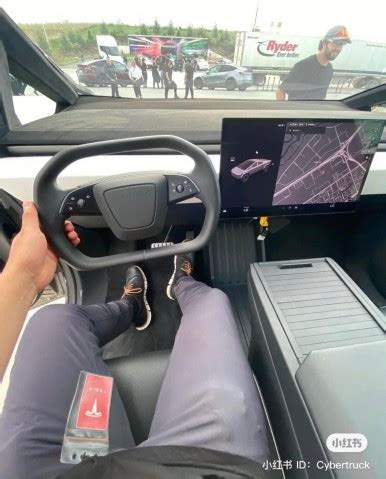
A black-and-white photo circulating online, purported to show a 1930s Soviet vehicle dubbed the “Tarantaika” and claimed to be a predecessor to Tesla’s Cybertruck, is misleading. While a vehicle called “Tarantaika” did exist in the Soviet Union during that era, the viral image actually depicts a custom-built art car created in 2018 by Finnish artist Matti Kähönen.
The claim gained traction across social media platforms, with many users suggesting that Elon Musk, Tesla’s CEO, drew inspiration from this supposed Soviet design. However, fact-checking investigations have debunked these assertions, confirming the image’s modern origin and its disconnection from any Soviet automotive prototypes. The confusion highlights the potential for misinformation to spread rapidly online, particularly when linked to popular figures and trending topics.
The viral image, which fueled comparisons to the Cybertruck due to its angular and utilitarian design, was quickly shared and amplified by various social media accounts. The narrative surrounding the photo suggested that the Soviet Union was experimenting with unconventional vehicle designs decades before Tesla’s Cybertruck entered the scene. This narrative tapped into existing interest in both the Cybertruck’s controversial design and historical Soviet technological endeavors. However, a closer examination revealed the true story behind the image.
According to a fact-check conducted by Reuters, the vehicle in the photo is not a historical artifact but a contemporary art piece. The image, taken in 2018, shows a creation by Finnish artist Matti Kähönen. The artist confirmed to Reuters that he built the vehicle himself, effectively disproving the claim that it was a 1930s Soviet design. “The vehicle is a work of art I made in 2018,” Kähönen stated, putting an end to the speculation about its origins.
The widespread sharing of the false claim underscores the challenges in discerning authentic information from misinformation online. In this case, the visual similarity between Kähönen’s art car and the Cybertruck’s distinctive aesthetic likely contributed to the virality of the inaccurate claim. The incident serves as a reminder of the importance of critically evaluating online content and verifying information through reputable sources before sharing it further.
The visual appeal of Kähönen’s art car, combined with the public fascination with the Cybertruck, created a perfect storm for misinformation. The angular, almost brutalist design of both vehicles resonated with a particular aesthetic, making the false connection seem plausible to many. The speed at which the claim spread highlights the ease with which misinformation can gain traction, particularly when it aligns with existing biases or interests.
Further investigation into the historical context of Soviet automotive design reveals that while the Soviet Union did produce a variety of vehicles during the 1930s, none of them bore a striking resemblance to the Cybertruck or Kähönen’s art car. Soviet automotive design during that period tended to focus on practicality and functionality, reflecting the needs of a rapidly industrializing nation. The designs were often influenced by Western automotive trends, but they were adapted to suit the specific conditions and requirements of the Soviet Union.
The incident also highlights the power of visual information in shaping public perception. The viral image of Kähönen’s art car provided a compelling visual narrative that was easily shared and understood. The fact that the image was accompanied by a false claim only amplified its impact, as many people were quick to accept the narrative without questioning its veracity.
The spread of misinformation surrounding the “Tarantaika” photo underscores the importance of media literacy and critical thinking skills in the digital age. It is crucial for individuals to be able to evaluate the credibility of online sources, identify potential biases, and verify information through multiple channels before accepting it as fact. The incident also highlights the responsibility of social media platforms to combat the spread of misinformation and promote accurate information.
In the wake of the viral claim, several fact-checking organizations have published articles debunking the connection between Kähönen’s art car and the Cybertruck. These fact-checks have provided detailed evidence to support the claim that the image is not a historical artifact and that it does not represent a Soviet automotive prototype. The fact-checks have also highlighted the importance of verifying information through reputable sources before sharing it online.
The incident serves as a cautionary tale about the potential for misinformation to spread rapidly online, particularly when it is linked to popular figures and trending topics. It also underscores the importance of media literacy and critical thinking skills in the digital age. By being more discerning consumers of online content, individuals can help to prevent the spread of misinformation and promote a more informed and accurate understanding of the world around them.
The Cybertruck, first unveiled in 2019, has been a subject of much discussion and debate due to its unconventional design. Its sharp angles, flat surfaces, and stainless steel exterior have been praised by some as futuristic and innovative, while others have criticized it as being aesthetically unappealing. The vehicle’s polarizing design has made it a frequent target of memes and jokes online, and it has also been the subject of numerous comparisons to other vehicles, both real and fictional.
The comparison to the supposed Soviet “Tarantaika” was just one of many such comparisons. However, it gained particular traction due to the visual similarity between Kähönen’s art car and the Cybertruck. The incident highlights the power of visual information in shaping public perception and the ease with which misinformation can spread online.
The name “Tarantaika” itself adds another layer to the story. While the vehicle in the viral photo is not a Soviet “Tarantaika,” the name does refer to a type of horse-drawn carriage used in Russia in the 19th century. The name evokes a sense of historical significance and adds to the mystique surrounding the false claim. The fact that the name has a real historical connection, albeit to a different type of vehicle, may have contributed to the plausibility of the claim.
The spread of the “Tarantaika” misinformation also highlights the echo chamber effect that can occur on social media. Users who are already interested in the Cybertruck or in Soviet history are more likely to encounter and share content related to those topics. This can create a situation where misinformation is amplified within specific communities, making it more difficult to correct.
The incident serves as a reminder that even seemingly harmless pieces of misinformation can have a significant impact. In this case, the false claim about the “Tarantaika” photo contributed to the spread of inaccurate information about Soviet automotive history and about the origins of the Cybertruck’s design. While the incident may seem trivial, it underscores the importance of combating misinformation in all its forms.
To combat the spread of misinformation, individuals can take several steps. First, it is important to be skeptical of information that is encountered online, particularly if it seems too good to be true or if it confirms existing biases. Second, it is important to verify information through multiple reputable sources before sharing it further. Third, it is important to be aware of the potential for misinformation to spread within specific communities and to take steps to correct it when it is encountered. Finally, it is important to support efforts to promote media literacy and critical thinking skills.
The incident involving the “Tarantaika” photo is just one example of the many challenges that individuals face in navigating the digital landscape. By being more discerning consumers of online content, individuals can help to prevent the spread of misinformation and promote a more informed and accurate understanding of the world around them. The incident also highlights the importance of collaboration between individuals, social media platforms, and fact-checking organizations to combat the spread of misinformation and promote accurate information.
The ongoing debate surrounding the Cybertruck’s design, its production timeline, and its potential impact on the automotive industry continues to fuel public interest and scrutiny. The vehicle’s unconventional appearance has made it a lightning rod for controversy, and the spread of misinformation surrounding the “Tarantaika” photo is just one example of the many challenges that Tesla faces in managing its public image. The company’s CEO, Elon Musk, has often used social media to engage with the public and to respond to criticisms of the Cybertruck. However, the spread of misinformation highlights the need for Tesla to be proactive in addressing false claims and in promoting accurate information about its products.
The “Tarantaika” incident also raises questions about the role of humor and satire in the spread of misinformation. Some users may have shared the photo as a joke, without intending to deceive anyone. However, even seemingly harmless jokes can contribute to the spread of misinformation if they are taken seriously by others. It is important to be mindful of the potential for humor to be misinterpreted and to take steps to ensure that jokes are not contributing to the spread of false information.
The incident serves as a reminder that the internet is a complex and ever-changing environment, and that individuals must be vigilant in protecting themselves from misinformation. By being more discerning consumers of online content, individuals can help to create a more informed and accurate online environment. The incident also highlights the importance of ongoing efforts to promote media literacy and critical thinking skills, and to combat the spread of misinformation in all its forms.
The “Tarantaika” photo’s journey from a piece of art to a viral sensation illustrates the unpredictable nature of online content. Its misattribution and the subsequent fact-checking efforts underscore the importance of verifying information before sharing it, especially in an era where visual content can easily be manipulated and spread rapidly. The incident serves as a case study in how misinformation can take hold, even when it seems implausible at first glance.
The fact that the artist, Matti Kähönen, was able to quickly confirm the origin of the vehicle highlights the importance of direct sourcing in fact-checking. By contacting the artist directly, Reuters was able to obtain definitive proof that the photo was not of a 1930s Soviet vehicle. This underscores the value of reaching out to primary sources when investigating potentially false claims.
The incident also raises questions about the role of algorithms in the spread of misinformation. Social media algorithms are designed to prioritize content that is likely to be engaging, which can sometimes lead to the amplification of false or misleading information. It is important for social media platforms to be aware of this potential and to take steps to mitigate the spread of misinformation through their algorithms.
The “Tarantaika” photo’s virality also highlights the power of nostalgia and historical curiosity. The idea of a 1930s Soviet vehicle that resembles the Cybertruck taps into a sense of wonder and intrigue. This suggests that misinformation that is linked to historical themes or that evokes a sense of nostalgia may be more likely to spread than other types of misinformation.
The incident serves as a reminder that the fight against misinformation is an ongoing process. It requires a concerted effort from individuals, social media platforms, fact-checking organizations, and educational institutions. By working together, these stakeholders can help to create a more informed and accurate online environment.
The Cybertruck itself continues to generate significant interest and anticipation, with potential buyers eagerly awaiting its release. The vehicle’s unique design and its promised performance capabilities have made it one of the most talked-about vehicles in recent memory. The spread of misinformation surrounding the “Tarantaika” photo is just one example of the many challenges that Tesla faces in managing the public perception of the Cybertruck.
The incident also highlights the importance of visual literacy in the digital age. Visual literacy is the ability to critically evaluate and interpret visual information. In the case of the “Tarantaika” photo, visual literacy would have involved questioning the authenticity of the image and verifying its origins before sharing it further.
The “Tarantaika” photo’s story is a complex one, involving art, technology, history, and misinformation. It serves as a reminder of the importance of critical thinking, media literacy, and collaboration in navigating the challenges of the digital age. By being more informed and discerning consumers of online content, individuals can help to create a more accurate and trustworthy online environment.
The event also encourages reflection on the nature of inspiration and design. While the “Tarantaika” wasn’t a direct influence on the Cybertruck, it sparks discussion about how designers draw ideas from various sources, consciously or unconsciously, and how historical contexts can shape contemporary creations. This highlights the interconnectedness of design across different eras and cultures.
Finally, the incident surrounding the “Tarantaika” image underscores the need for ongoing education about digital literacy and responsible online behavior. Promoting critical thinking skills and encouraging users to verify information before sharing it are essential steps in combating the spread of misinformation and fostering a more informed and trustworthy online environment. The digital age demands a proactive and informed citizenry capable of navigating the complexities of online information.
Frequently Asked Questions (FAQ)
1. Is the viral photo of a vehicle called “Tarantaika” actually a 1930s Soviet prototype that inspired the Tesla Cybertruck?
No. The viral photo shows a custom-built art car created in 2018 by Finnish artist Matti Kähönen, not a historical Soviet vehicle. Reuters confirmed this with the artist directly.
2. How did the false claim that the photo was of a Soviet vehicle originate and spread?
The claim originated on social media, likely due to the visual similarities between Kähönen’s art car and the Cybertruck’s angular design. The narrative tapped into existing interest in both the Cybertruck and Soviet technological history, making the false connection seem plausible to some users.
3. What evidence disproves the claim that the photo shows a 1930s Soviet vehicle?
Matti Kähönen, the artist who created the vehicle in the photo, confirmed that he built it in 2018. Fact-checking organizations like Reuters also investigated the claim and found no evidence to support the existence of a similar Soviet vehicle from the 1930s.
4. What lessons can be learned from the spread of this misinformation?
The incident highlights the importance of media literacy, critical thinking, and verifying information through reputable sources before sharing it online. It also underscores the role of social media platforms in combating the spread of misinformation.
5. What is the real “Tarantaika,” and does it have any connection to the vehicle in the photo or the Cybertruck?
The term “Tarantaika” refers to a type of horse-drawn carriage used in Russia in the 19th century. It has no direct connection to the vehicle in the viral photo or the Cybertruck. The use of the name in connection with the art car appears to be coincidental and contributed to the historical mystique surrounding the false claim.









